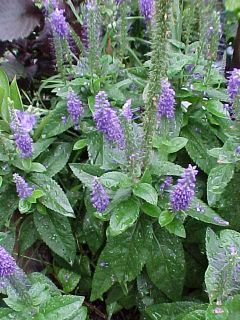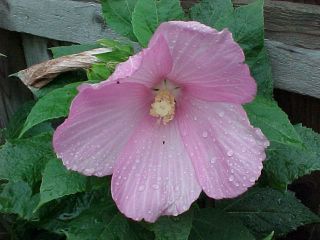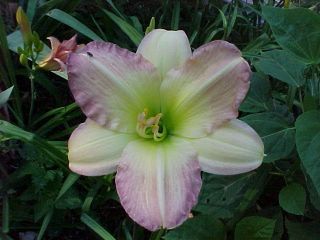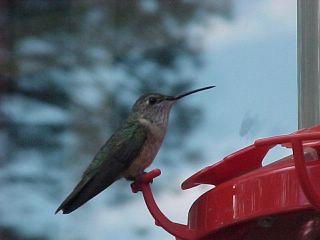Wednesday, August 31, 2005
The Best Grow Almost Anywhere Annual
And the winner is...
Summer Flowering Balsam.
And it does grow just about anywhere.
About all it requires is a decent amount of moisture and semi-good soil. And I'm not even sure if it requires that.
It's growing in the cracks at the bottom of the stairwell on the north side of my house.
I don't water the stairwell.
It hasn't rained much here this summer either.
I will admit that it does much better in some locations than others. It does not like the front yard for some reason. (I think it's the thirsty maple tree.) But when it finds a spot it likes...
It really likes it.
Summer flowering balsam is a member of the impatiens family. Like most of the impatiens, it likes water and doesn't mind shade. It also blooms profusely in late summer when much of the garden has kind of faded out. It can get quite tall, up to 3 feet in height, and it comes in a wide variety of colors. It comes in lots of hot pinks and bright shades of blue-lavender and corals, along with the paler pinks. There's even a variety with white spots on the flowers.
I'm not kidding.
Spots.
Once they have managed to bloom themselves out, or when the frost gets them, they can easily be pulled up to make room for something different.
It's one drawback (which might be a good thing for some people) also gives it another one of it's names: Touch-me-nots. It's seed pods explode, sending hundreds of small seeds everywhere. And if they like where they land, they will grow next spring.
Even if it's a crack in the sidewalk.
This does make it a bit of a pest if you have it in a mixed border. But the seedlings are easy to pull out. Just remove the ones that grow where you don't want them too.
Instant repeating color.
And the bees like them too.
Sunday, August 21, 2005
New Links For All
I've been working on something new.
Photos, photos, photos!
I love to take photos of nature and places I've been, so I decided to make an online photo album or two to share with everyone.
One album is photos of places I've been. Just a selection of some of my favorite photos of some of my favorite places.
Another album is of flowers I grow (or have grown) in my yard.
The last (at the moment) (until I get the bug to form another new album) is of bugs and animals I've found to take photos of.
None of the photos are from zoos or butterfly houses.
That would be cheating.
I hope you find the time to take a cruise through my eyes.
It's quite an adventure.
Wednesday, August 17, 2005
Best 'Grows Anywhere'
And the winner is...
The humble Black-Eyed Susan.
While often guilty of being a thug in the garden, this delightful late summer bloomer still gets the nod for the best plant to grow just about anywhere. Full sun to deep shade. Moist to dry. It may not thrive in all those conditions, but it will usually survive and bloom.
The only condition it seems to detest is bone dry.
It does need water occasionally.
This old fashioned plant is definitely a garden staple. For the most part it is a 'plant and forget' flower. Very little additional care is needed.
Aside from pulling up all it's little wandering babies.
(That was a warning.)
If you want a plant to fill a problem spot, this might be the one.
Yes, it tends to re-seed more than most people want.
Yes, it keeps spreading.
But it also blooms with that glorious splash of color that signals the onset of fall, and transitions us from the height of summer color to the rusts and yellows of fall.
I read someone say that there are no invasive plants. Some just require a bit more work than others. This particular person was growing some very invasive plants. They just loved them anyhow and took the time to keep them 'inbounds'.
So, in spite of the spreading and re-seeding (which might be considered a bonus to some), I still give the Black-Eyed Susan the Grow Anywhere Award. You just can't beat it for it's ability to look lovely just about anywhere.
It does seem to be a bit more well behaved in shade. Same cheery yellow flowers with the dark eyes, just not as vigorous. A little bit of competition goes a long way towards taming the beast.
So find that problem spot and give Susie a try.
Just remember to add water.
Tuesday, August 16, 2005
The Best of the Blues
And the winner is...
Veronica spicatica
No specific cultivar. Just the blue ones.
This lovely plant starts blooming early to midsummer, and just keeps going, and going and going...
Kind of like the energizer bunny.
It's no wonder it was the 1993 Perennial Plant of the Year.
Veronica has lance shaped leaves with serrated edges, ranging from a dull grey green to a rich deep green. But it's the blue shades that really catch they eye.
Veronica's flower spikes are held high above the foliage in the most wonderful shades of blue. My personal favorite is what I believe is 'Sunny Border Blue', but I'm not positive on the cultivar. It is the richest deep blue in my yard. Kind of a cross between navy and royal blue. It looks stunning paired with a yellow.
The spikes bloom from the bottom up and keep getting longer and longer as they bloom. The spikes themselves can form interesting shapes as they elongate and sometimes split into multiple spikes. As the main spike blooms, a myriad of side blooms also form. And keep blooming, and blooming, and blooming. If you clip off the spikes once they finally stop blooming, more will form, giving you that glorious continual shade of blue well into fall.
Veronica is not a picky plant. It is happy in sun or part shade, and survives drought conditions well. There are many colors of Veronica, and shapes and sizes too, ranging from ground covers to very tall. It is well behaved and does not re-seed at will. It is, however, easy to propagate in spring by cuttings. Simply take a new shoot in spring, cut it off, strip the lower leaves, and keep in moist soil until roots form.
Every garden should have at least one Veronica.
But I do have to give two other plants honorable mention when it comes to blue.
And both are common weeds.
Spiderwort and chicory.
The baby blue of chicory is simply lovely, most often seen growing on the roadside in a stunning display with queen-anne's-lace. An herb most often grown as a coffee substitute, it has escaped to grace the ditches with a wave of blue. This is a now you see it, now you don't plant. The blooms are open in the morning, and closed in the afternoon. It can grow to be a tall coarse plant, so it's not well suited for the typical garden. But if you have that wild area...
My other favorite blue is Spiderwort, tradescantia virginiana. This wildflower will grow in sun or shade (though it's floppy in shade), wet or dry conditions. It will keep producing blue-violet flowers all summer long. While not as neat or showy as some of the cultivars, I've found it to bloom longer and it does not usually go dormant in the summer. It can get a bit floppy without something to hold it up, and it does tend to pop up around the garden on it's own, so it's not for the picky gardener. Picky people should try the more modern cultivars.
Sunday, August 14, 2005
Best Giant Bloom
And the winner is...
The Hardy Hibiscus
If you are looking for an eye-catching larger than life bloom, I really can't think of any other plant that fits the bill.
We are talking dinner plate sized blooms here.
And in a variety of colors from white to deep red.
This baby is a relative of the Rose of Sharon shrub, and a member of the mallow family. Native to much of America, it is often called Swamp Mallow, but it can survive in a wide variety of conditions.
It can grow to about 5 feet or taller in height, and has nice large heart shaped leaves. Some varieties have leaves more like the Japanese maple. The glossy leaved hibiscus are tropical, and come in more tropical colors of yellow through orange red. Glossy leaved hibiscus are not cold hardy.
The hardy hibiscus is cold tolerant to at least zone 5, and perhaps zone 4 in certain situations. They do die back to the ground in winter, but always come back in late spring. Very late spring. It is a good idea not to cut the dead stalks back until spring so you can remember where they are located.
They are relatively easy to grow from seed, and will often self-sow. Color will not come true from seed. If you plant to grow them from seed, nick the seeds and soak them overnight before planting. It usually takes 2 years for a new plant to bloom. As with most plants, they only improve with age, growing more and more shoots from the original root to form a small shrub-like plant.
This one will give you a taste of the tropics.
Saturday, August 13, 2005
Best for Genetic Experiments
And the winner is....
The Daylily
If you like to play bumble bee and try to cross-pollinate plants in your yard for fun, the daylily is your ticket for success.
All you really have to do is pick off one of the long pollen thingies, take it to a different daylily and rub the pollen all over the end of the long tube-like center thingy. (I'm being real technical here.) Then you wait for the large seed pod that will hopefully develop. When the pod starts to spread open, the seeds are ready to pick. At this point you can store them in the refrigerator and plant them in spring. Two years later, you will have a new daylily bloom genetically unlike any other.
While two years may seem like a long time to wait, it is really worth the fun of going out every day during bloom season to see what new creation is blooming. No two are exactly alike, not even if the seeds came from the same pod. Not even height or bloom color will be identical. They won't all be stunning beauties, but all will usually have their own merits.
Blooming babies everywhere.
Of course, then you have to find homes for them all. That could be a problem. Daylilies aren't small plants.
While there are other plants out there that could be used for genetic experimentation, daylilies are quite simply easy to grow, easy to pollinate, hardy in a wide variety of conditions and plant zones, and produce showy blooms.
Easy instant gratification.
Here are some other qualifications. Daylilies aren't terribly prone to disease. They survive neglect well. Some grow very rapidly. They come in every color but blue. They come in a wide variety of bloom shapes, some quite exotic. They even do well in poor soil and part shade. They are quite drought tolerant, though they won't bloom as well in a heavy drought. They can be quite addictive.
So if you feel like playing with genetics, daylilies are the way to go.
I have only one caution.
It'll be really difficult to let your creation babies go.
Friday, August 12, 2005
Flower Award Series
I have decided to make up my own little flower award series.
Too many flowers. Far to difficult to pick just one favorite.
Each category will have just one flower as a winner.
(This might stretch my judging capabilities a bit.)
I have an incredibly long list of categories, and a matching list of flowers that belong in a category.
This might take a while.
I have to admit up front that I don't have set rules for my judging, other than I have to grow them myself. This does limit the entries slightly as there are a lot of plants that I simply don't grow.
On the other hand, I probably have over 900 different types of plants growing in my yard, so I'm not as limited in choices as you'd think.
Stay tuned for some gardening fun!
Monday, August 08, 2005
Garden Party
I've been absent for a while due to a graduation party for my daughter.
Most of the preparations were on the inside of the house, complicated by the installation of new carpeting.
It was a big job.
The party was a smashing success.
About 50 friends and family attended and enjoyed the parklike setting, wonderful sunny day, and a lovely balmy evening.
The garden was a hit too.
Comments included:
I wasn't sure I was at the right place. I knew you had lots of flowers, but you can't tell from the front yard. (My front yard is deceptively small)
I love what you did where your pool was. (I had a twenty-four foot above ground pool that went to it's reward two years ago. It's now garden.)
Look! A moonflower. (I love this old fashioned oddity.)
What's that yellow flower with the lacy leaves? (A wild senna or partridge pea.)
Do you have to add water to your pond? (Yes, when it doesn't rain enough.)
You must spend a lot of time out here. (My family says they never see me during the summer.)
It must take a lot of work. (Not as much as you think. Truthfully spring clean up and three good weedings usually does the trick. The rest is putzing.)
Do you have to water a lot? (Typically no. But I usually water more than I need to because I'm always moving plants around.)
It's just beautiful. (Don't look too close because it's been too hot and I haven't been weeding like I should...which I will pay for later.)
Have you had to water a lot with the drought?(Actually, no. A few plants needed the water. Most thrived anyhow, but were about 6 inches shorter than usual, not that you can tell.)
What's your favorite plant?(I never did get a chance to answer this one. Tough question. Plant would probably be hosta. For flower I'd almost have to say whatever is blooming at the moment. Actually, the false sunflower is quietly taking the lead, blooming from spring to fall and beyond. Close second would be my dark blue veronica. Both have very long bloom seasons. I'll have to make a best of list.)
In any case, the garden was a big hit, along with all the food and drink.
Though there were a few surprise guests.
In spite of the 50 people scattered about the yard, the locals still snuck in.
During one of my more relaxed moments, I enjoyed watching a hummingbird get a free drink from my beautiful 'Raspberry Wine' bee balm. I didn't invite him to the party, but he's always welcome.
We also got to watch the merry goldfinches munch on sunflower and cosmos seeds. The food was plentiful.
I do like a good garden party.
You always end up with the most engaging guests.










